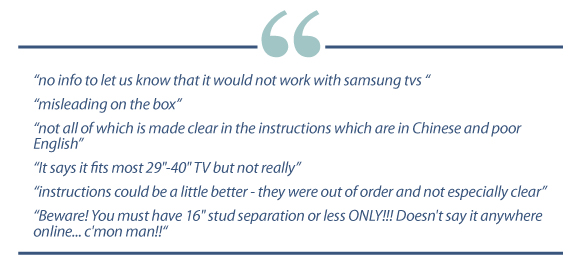
If you’ve ever seen online customer comments like those above (and they’re all real) and decided against a purchase, you aren’t alone. According to some studies, 97% of consumers factor online comments into their purchase decisions. When considered with ratings, comments like those above create doubt and uncertainty in the mind of potential customers. Concerns about quality—real or not—can have a powerful impact on consumer behavior and affect how well a brand does in the marketplace.
This can be especially true for private label products that, despite improved perceptions and frequently-proven performance, are still viewed by many as a lower quality than those of established brands. Private label brands still have a minority share of the market. They have to compete with bigger brands (with bigger budgets) so sometimes struggle for recognition. With Valentine’s Day behind us, it’s a good time to ask, “What can private label retailers do to make customers feel the love?”
Kathy Sierra, author of Badass: Making Users Awesome, notes that successful products are more about how users feel when using your product, not what the product does. She says that, when people feel good about themselves because of a product and, by extension, a brand, they love them both. It’s a great reminder that an extraordinary customer experience starts with a great product, but customer communications can contribute to that experience or stop it dead in its tracks. For private label marketers who don’t realize or recognize this, the end result is customer disappointment and a tarnished brand image. It doesn’t have to be that way.
From awareness and consideration to purchase and usage, there are numerous customer communication touch points. Each one offers a unique opportunity to provide an experience that delights customers, maintains brand integrity, and strengthens that relationship long after purchase. Developing that relationship means you need to know your target audience because their communications needs will vary from product to product and person to person.
For example, gamers may be keenly interested in product specs and technical features of a new gaming device. A new mom, on the other hand, may want to understand how features of a car seat will protect her new baby. The warranty might be a big deal to her.
Even the way you provide information should be tailored to the target audience in a way that they can relate to. Not communicating what customers need or providing it poorly sends the message that they don’t matter and you don’t care. It makes them question product quality and raises feelings of frustration and disgust. Avoid this with a reputation-building communications strategy that considers these touch points:
- Online product/detail page – According to the 2017 Retail Dive Consumer Survey, 65% of purchases start with online research. That can include articles, product videos, and online reviews from other customers and influencers. For many shoppers, this is where they form a first impression of a product that determines whether or not they go any further. Make it a positive one by providing the information customers need and want to make an informed purchase decision. Features, benefits, compatibility, package contents, specs, warranty, product image, video, even support documentation—all of these provide valuable information.
More importantly, when part of a carefully-planned and executed communications strategy, they tell the story of your brand and a good story triggers an emotional connection that converts prospects and increases organic website traffic. Different customers look for different things so make sure you provide it all in an inviting and compelling way that resonates with that audience. If your product is available online only, this is a critical step in the customer journey and path toward building brand credibility.
- Packaging – more than 55% of consumers visit stores before buying online. If you want their business or that of those who purchase in-store without the preamble of online research, you have one chance to make a first impression and it starts with packaging. It is one of the most important components of marketing. About more than just protecting the product inside, packaging must reflect the brand and sell the product.
Just like you might on a website, make sure packaging has what buyers need to make an informed decision. Features, benefits, compatibility, package contents, specs, and warranty—all of these say something about your product. It’s not enough, however, to slap that on packaging and call it good. How that information is presented and, even the type of packaging structure used, reflect your brand and tell a story about your product. Content, design, and structure must be work together to attract attention, to pull buyers in, and to showcase your product. All play a part in setting your product apart from others and making customers feel good about it.
- Product documentation – this is, perhaps, the most overlooked and undervalued type of customer communications, yet it can have a huge and lasting impact on customer experience with your product, particularly if there is any level of complexity to it. Private label products are notorious for skimping on this. Maybe it’s because, except for a new logo, the product is basically off-the-shelf. Maybe it’s because, by the time they get to production, they’ve already spent a lot of money. They may think it’s acceptable to use whatever the manufacturer might have created for the product because other brands have used it.
This is both wrong and dangerous. It is wrong because, while vendor documents might be created by people with an intimate understanding of the product, they often have a limited understanding of the end user and their needs. It’s unreasonable, for example, to expect that a young engineer in Taiwan can communicate important information in a way that an American senior citizen can understand. It’s particularly dangerous when vendor-written documents gloss over or miss important safety language. Many times, those authoring vendor documents don’t even share the same language as end users so documents end up including a confusing mix of multiple languages which reflects poorly on both the product and the brand.
The fact is, regardless of what form it takes—printed, online, on-product or other—product documentation helps customers get the most out of their new product. Done properly and with customers in mind, it can help reduce expensive support calls and product returns. Ultimately, it can enhance a customer’s experience with your product and improve the chances of them becoming a brand advocate for you.
- Support materials – even after purchase, the customer relationship matters. Tech support, social media, chat, email, community forums—all offer an opportunity to enhance a customer’s experience, to show them that they are valued, and to reassure them that they made a good purchase decision. Even simple FAQs can make a difference by giving customers a chance to solve a problem on their own and before calling tech support. The Nielson Norman Group says, “a usable website FAQ can improve products, services, information, and user experience.”
Is your tech support team trained to provide customers with the answers they need? Are chat and social media teams responsive and empowered to help customers? Is someone actively monitoring community forums? Providing customers with a great experience after initial purchase can go a long way toward making them loyal to your brand. Often expected from big name brands, post-purchase support is welcome. Kathy Sierra reminds brands that customers “assign equity to your brand and may forgive future missteps, as long as your product continues to deliver on its promise.”
Almost every consumer product category has private label offerings and, while it still makes up a minority of the market, there is tremendous potential for continued growth on a global scale. Create a memorable, outstanding experience for customers by providing them with the information they need to get the most out of their private label product. Earn their love. As Maya Angelou once said, “At the end of the day, people won’t remember what you said or did, they will remember how you made them feel.” Using effective communications to make customers feel great will go a long ways toward making them love you and your private label brand.
Sources:
http://www.adweek.com/brand-marketing/infographic-how-omnishoppers-browse-and-buy/
https://www.doztrading.com/blogs/articles/why-private-labeling-advantages-disadvantages
https://www.retaildive.com/news/inside-the-retail-dive-consumer-survey/441572/











